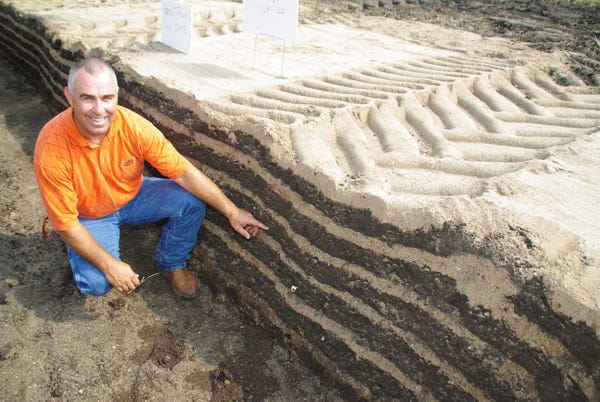January 1, 2012

Are tracks or tires better for reducing compaction from loaded grain carts? “The answer is, it depends,” says Randy Taylor, an Oklahoma State University Extension ag engineer.
At one of his recent soil-pit demonstrations showed the relative differences in shallow and deep compaction between heavy grain carts equipped with tires or tracks.
A 729-bu. grain cart on tracks at 16 psi, loaded with 700 bu. of corn, created less compaction in the top 6-8 in. than carts equipped with 800/65R32 radial tires or 30.5-32 bias ply tires, both inflated to 30 psi. “That’s what we would expect,” Taylor says.
However, the effects of tires vs. tracks on deep compaction appeared to be about the same. Deeper compaction is a function of axle load, he notes. Taylor’s hunch: “Tracks probably reduce deep compaction compared to tires, but we don’t have research to show that.”
Generally, Taylor puts tracks ahead of dual or triple tires “from a compaction standpoint.” That’s because duals or triples widen the compaction zone, while tracks spread weight across a longer, narrower length. However, “You won’t see that advantage all the time,” he says. Soil conditions are a big factor – another case of “it depends.” Instead of triples, “I’d rather see taller dual tires,” Taylor says.
Economics come into the choice between tires or tracks, too. “Tracks cause less compaction, but they cost more. Does less compaction pay for the tracks?” The answer varies by farm, he says.
Compaction Pit
Farmers at a late summer field day got a “mole’s eye view” of soil compaction.
Experts from the University of Minnesota Extension and North Dakota State University Extension built unusual layered soil pits to show the effects of wheel traffic and heavy machinery on soil structure.
Three-foot-deep soil pits were excavated in a harvested wheat field on the Don and Dan Bradow farm, French, MN. Then the black soil was put back into the pits in 4-in. layers, with each layer separated by a 2-in. band of light-colored, washed sand. Picture a seven-layer chocolate cake with caramel frosting between each layer.

Loaded grain carts and tractors with a variety of tire and track configurations were driven over the pits one or more times. Then the pits were opened up again, revealing the layers of soil and sand. The compaction effects of heavy field equipment, multiple machinery passes and incorrect tire inflation were visible in the undulating layers below ground.
Because the layered soil pits are an artificially created environment, the effects of machinery traffic were not exactly the same as they’d be in a field, notes Jodi DeJong-Hughes, a University of Minnesota Extension tillage expert. But the pits are a great way to visualize the unseen damage that can be done to your soil during field operations, she says.
“Heavy field equipment can compact the soil down to 4 ft. and affect crop yields for years to come,” DeJong-Hughes says. A multi-state study from 1988 to 2002, for example, shows that deep compaction depressed corn and soybean yields about 5% for 12 years, compared to an uncompacted control – even though no further compaction occurred during those 12 years, says Randall Reeder, a retired Ohio State University Extension ag engineer.
“However, small changes in your management and equipment maintenance can have significant positive effects in your fields,” DeJong-Hughes says. Controlling axle loads, properly inflating tires and avoiding tillage when soil is wet are examples.
How cover crops alleviate compaction
Compaction happens. Machinery traffic, tillage, raindrop impact and field operations on wet soil all contribute to soil compaction.
Signs of compaction include poor soil drainage due to low infiltration, standing water and excessive runoff because of reduced porosity, says Jay Jabro, a research soil scientist at the USDA-ARS Northern Plains Agricultural Research Laboratory in Sidney, MT.
Compacted soil is cloddy, hard to work and prone to surface crusting and cracking. Crops growing in compacted soil show shallow or abnormal roots, uneven stands and reduced yields.
But when it comes to the remedy, “You don’t always need steel,” says Hal Weiser, a soil specialist with the North Dakota Natural Resources Conservation Service. “There are other options for dealing with compaction.”
Perennials and annual plants with strong taproots are very effective at alleviating compaction, he says. A cash crop like sunflower has “a deep, aggressive taproot” that can break through tillage pans.
Forage radish, a cool-season cover crop, is also very effective at breaking through compaction layers. Planted in late summer, after winter wheat, spring wheat or early corn-silage harvest, tillage radish will keep growing as long as nighttime temperatures are above 18° F, he says. Even in North Dakota, with its short growing season, radishes seeded in early August can reach 1-2 in. in diameter and 10-14 in. long, he adds.
Some livestock producers are interseeding forage radish into corn at V-6 for fall grazing after harvest. By spring, Weiser says, “The residue is gone. All that remains is the skeleton.” Corn planted the next spring “just follows the radish right down.”
The very best crop for breaking through compaction layers is alfalfa, with its deep taproot system, Weiser says. He suggests growers try out “bio-tillage” on small problem areas, like compacted headlands or low spots within fields, which are often worked wet.
About the Author(s)
You May Also Like




